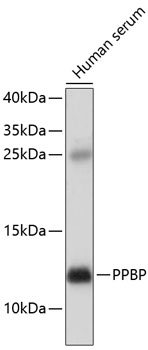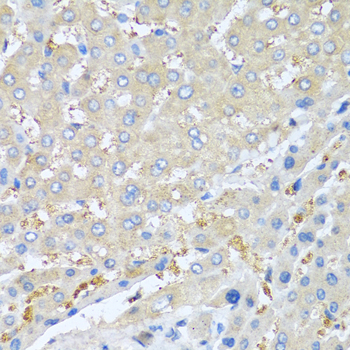Cell Biology Antibodies 7
Anti-PPBP Antibody (CAB1925)
- SKU:
- CAB1925
- Product Type:
- Antibody
- Reactivity:
- Human
- Host Species:
- Rabbit
- Isotype:
- IgG
- Research Area:
- Cell Biology
Description
| Antibody Name: | Anti-PPBP Antibody |
| Antibody SKU: | CAB1925 |
| Antibody Size: | 20uL, 50uL, 100uL |
| Application: | WB IHC |
| Reactivity: | Human |
| Host Species: | Rabbit |
| Immunogen: | Recombinant fusion protein containing a sequence corresponding to amino acids 31-128 of human PPBP (NP_002695.1). |
| Application: | WB IHC |
| Recommended Dilution: | WB 1:500 - 1:1000 IHC 1:50 - 1:100 |
| Reactivity: | Human |
| Positive Samples: | Human serum |
| Immunogen: | Recombinant fusion protein containing a sequence corresponding to amino acids 31-128 of human PPBP (NP_002695.1). |
| Purification Method: | Affinity purification |
| Storage Buffer: | Store at -20'C. Avoid freeze / thaw cycles. Buffer: PBS with 0.02% sodium azide, 50% glycerol, pH7.3. |
| Isotype: | IgG |
| Sequence: | TALA SSTK GQTK RNLA KGKE ESLD SDLY AELR CMCI KTTS GIHP KNIQ SLEV IGKG THCN QVEV IATL KDGR KICL DPDA PRIK KIVQ KKLA GDES AD |
| Gene ID: | 5473 |
| Uniprot: | P02775 |
| Cellular Location: | Secreted |
| Calculated MW: | 13kDa |
| Observed MW: | 14kDa |
| Synonyms: | PPBP, B-TG1, Beta-TG, CTAP-III, CTAP3, CTAPIII, CXCL7, LA-PF4, LDGF, MDGF, NAP-2, PBP, SCYB7, TC1, TC2, TGB, TGB1, THBGB, THBGB1 |
| Background: | The protein encoded by this gene is a platelet-derived growth factor that belongs to the CXC chemokine family. This growth factor is a potent chemoattractant and activator of neutrophils. It has been shown to stimulate various cellular processes including DNA synthesis, mitosis, glycolysis, intracellular cAMP accumulation, prostaglandin E2 secretion, and synthesis of hyaluronic acid and sulfated glycosaminoglycan. It also stimulates the formation and secretion of plasminogen activator by synovial cells. The protein also is an antimicrobial protein with bactericidal and antifungal activity. |
| UniProt Protein Function: | PPBP: LA-PF4 stimulates DNA synthesis, mitosis, glycolysis, intracellular cAMP accumulation, prostaglandin E2 secretion, and synthesis of hyaluronic acid and sulfated glycosaminoglycan. It also stimulates the formation and secretion of plasminogen activator by human synovial cells. NAP-2 is a ligand for CXCR1 and CXCR2, and NAP-2, NAP-2(73), NAP-2(74), NAP-2(1-66), and most potent NAP-2(1-63) are chemoattractants and activators for neutrophils. TC-1 and TC-2 are antibacterial proteins, in vitro released from activated platelet alpha-granules. CTAP-III(1-81) is more potent than CTAP-III desensitize chemokine-induced neutrophil activation. Belongs to the intercrine alpha (chemokine CxC) family. |
| UniProt Protein Details: | Protein type:Secreted, signal peptide; Secreted; Chemokine Chromosomal Location of Human Ortholog: 4q12-q13 Cellular Component: extracellular space; extracellular region Molecular Function:growth factor activity; chemokine activity; CXCR chemokine receptor binding; glucose transmembrane transporter activity Biological Process: platelet activation; response to lipopolysaccharide; positive regulation of leukocyte chemotaxis; glucose transport; leukocyte migration during inflammatory response; regulation of cell proliferation; G-protein coupled receptor protein signaling pathway; platelet degranulation; positive regulation of cell division; defense response to bacterium; immune response; blood coagulation; inflammatory response |
| NCBI Summary: | The protein encoded by this gene is a platelet-derived growth factor that belongs to the CXC chemokine family. This growth factor is a potent chemoattractant and activator of neutrophils. It has been shown to stimulate various cellular processes including DNA synthesis, mitosis, glycolysis, intracellular cAMP accumulation, prostaglandin E2 secretion, and synthesis of hyaluronic acid and sulfated glycosaminoglycan. It also stimulates the formation and secretion of plasminogen activator by synovial cells. [provided by RefSeq, May 2010] |
| UniProt Code: | P02775 |
| NCBI GenInfo Identifier: | 129874 |
| NCBI Gene ID: | 5473 |
| NCBI Accession: | P02775.3 |
| UniProt Secondary Accession: | P02775,Q6IBJ8, B2R5F3, |
| UniProt Related Accession: | P02775,AAB46877 |
| Molecular Weight: | 13,894 Da |
| NCBI Full Name: | Platelet basic protein |
| NCBI Synonym Full Names: | pro-platelet basic protein (chemokine (C-X-C motif) ligand 7) |
| NCBI Official Symbol: | PPBP |
| NCBI Official Synonym Symbols: | PBP; TC1; TC2; TGB; LDGF; MDGF; TGB1; B-TG1; CTAP3; CXCL7; NAP-2; SCYB7; THBGB; LA-PF4; THBGB1; Beta-TG; CTAPIII; CTAP-III |
| NCBI Protein Information: | platelet basic protein; thrombocidin 1; thrombocidin 2; beta-thromboglobulin; CXC chemokine ligand 7; C-X-C motif chemokine 7; thromboglobulin, beta-1; small inducible cytokine B7; small-inducible cytokine B7; leukocyte-derived growth factor; low-affinity platelet factor IV; neutrophil-activating peptide 2; neutrophil-activating peptide-2; macrophage-derived growth factor; connective tissue-activating peptide III; small inducible cytokine subfamily B, member 7 |
| UniProt Protein Name: | Platelet basic protein |
| UniProt Synonym Protein Names: | C-X-C motif chemokine 7; Leukocyte-derived growth factor; LDGF; Macrophage-derived growth factor; MDGF; Small-inducible cytokine B7Cleaved into the following 10 chains:Connective tissue-activating peptide III; CTAP-III; Alternative name(s):; LA-PF4; Low-affinity platelet factor IV |
| Protein Family: | Placenta growth factor |
| UniProt Gene Name: | PPBP |
| UniProt Entry Name: | CXCL7_HUMAN |
View AllClose








